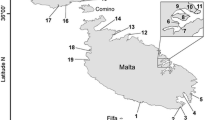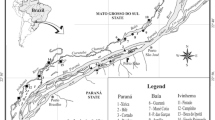Abstract
During the BENTART 95 survey, epifauna was sampled with an Agassiz trawl at 24 stations ranging from north of Livingston Island (South Shetland Islands) to the Antarctic Peninsula at depths from 40 to 850 m. Four assemblages of ophiuroids were identified and correspond to Deception Island, Trinity Island, and the southern and northern zones of Livingston Island. In addition to these regions, gradients related to depth and filter-feeder biomass were found. The brittle-star assemblages were dominated by Ophionotus victoriae Bell, 1902, which to a large extent determine the biogeographic structure in the South Shetland Islands.






Similar content being viewed by others
References
Acosta J, Catalán M, Hérranz P, Sanz JL (1990) Perfiles sísmicos en las Shetland del Sur y estrecho de Bransfield. Estructura y dinámica reciente. In: Castellví J (ed) Actas del Tercer Símposium Español de Estudios Antárticos. Comisión Interministerial de Ciencia y Tecnología, Madrid, pp 281–296
Arnaud PM, Galeron J, Arntz WE, Petersen GH (1990) Semiquantitative study of macrobenthic assemblages on the Weddell Sea shelf and slope using trawl catch subsamples. In: Arntz WE, Ernst W Hempel I (eds) The Expedition ANTARKTIK VII/4 (EPOS leg 3) and VII/5 of RV Polarstern in 1989. Ber Polarforsch 6:98–104
Arnaud PM, Lópoz CM, Olaso I, Ramil F, Ramora-Esplá AA, Ramos A (1998) Semi-quantitative study of macrobenthic fauna in the region of the South Shetland Islands and the Antarctic Peninsula. Polar Biol 19:160–166
Arnaud PM, Troncoso JS, Ramos A (2001) Biodiversity and assemblages of macrobenthic Mollusca from South Shetland Islands and Bransfield Strait (Antarctica). Polar Biol 24:105–112
Baroni-Urbani C, Buser MW (1976) Similarity of binary data. Syst Zool 25:251–259
Bernasconi I (1970) Equinodermos antárticos II: Asteroideos. 3. Asteroideos de la extremidad norte de la Península Antártica. Rev Mus Argent Cienc Nat Bernardino Rivadavia Inst Nac Invest Cienc Zool 9:211–281
Bernasconi I, D'Agostino MM (1971) Ofiuroideos argentinos. Claves para los órdenes subórdenes, familias, subfamilias y géneros. Physic 30:447–469
Branch ML, Jangoux M, Alvá V, Massin, CL, Stampanato S (1993) The Echinodermata of subantarctic Marion and Prince Edward Islands. S Afr J Antarct Res 23:37–70
Clark AH (1951) The brittle-stars of the United States Navy Antarctic Expedition 1947-48. J Wash Acad Sci 41:26–30
Clark AM (1970) Notes on the Family Amphiuridae (Ophiuridae). Bull Br Mus Nat Hist Zool 19:1–81
Dearborn JH (1977) Food and feeding characteristics of Antarctic asteroids and ophiuroids. In: Llano GA (ed) Adaptations within Antarctic ecosystems. Gulf, Houston, pp 293–326
Fell HB (1960) Synoptic keys to the genera of Ophiuroidea. Zool Publ Victoria Univ Coll Wellington 26:1–44
Fell HB (1961) The fauna of the Ross Sea. Part 1. Ophiuroidea. N Z Dep Sci Ind Res Bull 142
Fell HB (1962) A revision of the major genera of Amphiurid Ophiuroidea. Trans R Soc N Z Zool 2:1–26
Fisher WK (1940) Asteroidea. Discovery Reports, National Institute of Oceanography, Cambridge 20, pp 69–306
Fratt DB, Dearborn JH (1984) Feeding biology of the Antarctic brittle star Ophionotus victoriae (Echinodermata: Ophiuridea). Polar Biol 12:283–290
Gallardo JG (1987) Benthic macrofauna of Antarctic sublittoral soft bottoms. BIOMASS Antarct Aquat Biol l7:73–86
Gallardo JG (1992) Estudios bentónicos en bahías someras Antárticas del Archipiélago de las Islas Shetland del Sur. In: Gallardo VA, Ferreti O, Moyano HI (eds) Oceanografía en la Antártida. Centro Eula de la Universidad de Concepción, pp 383–393
Gallardo VA, Castillo JG, Retamal MA, Yánez A, Moyano HI, Hermosilla JG (1977) Quantitative studies on the soft-bottom macrobenthic animal communities of shallow Antarctic Bays. In: Llano GA (ed) Adaptations within Antarctic ecosystems. Gulf, Houston, pp 361–387
Gracia E, Canals M, Farrán M, Prieto MJ, Sorribas J, Gebra Team (1996) Morphostructure and evolution of the central and eastern Bransfield Basins (NW Antarctic Peninsula). Mar Geophys Res 18:429–448
Grieg JA (1929) Echinodermata from the Palmer Archipelago, South Shetlands, South Georgia and Bouvet Island. Scientific results of the Norwegian Antarctic Expedition (1927, 1928 and 1929) Oslo 2:1–16
Hertz M (1927a) Die Ophiuriden der Deutschen Tiefsee-Expedition. I. Chilophiurida Matsumoto (Ophiolepididae, Ophioleucidae, Ophiodermatidae, Ophiocomidae). Wiss Ergebn Dtsch Tiefsee-Exped Dampfer Valdivia (1898–1899) 22:59–122
Hertz M (1927b) Die Ophiuroiden der Deutschen Südpolar-Expedition (1901–1903), Dtsch Südpolar Exped (1901–1903) Zoologie 2:1–56
Jazdzewski K, Sicinski J (1993) Zoobenthos. General remarks. In: Rakusa-Suszcewski S (ed) The maritime Antarctic coastal ecosystem of Admiralty Bay. Pol Acad Sci 12:83–95
Kellogg DE, Kellogg TB, Dearborn JH, Edwards KC, Fratt DB (1982) Diatoms from brittle star stomach contents: implications for sediment reworking. Antarct J US 17:167–169
Koehler R (1906) Echinodermes (Stellerides, Ophiures et Echines). Expéd Antart Fr (1903–1905):1–41
Koehler R (1908) Astéries, Ophiures et Échinides de l'Expédition Antarctique Écossaise. Trans R Soc Edinburgh 46:529–649
Koehler R (1912a) Échinodermes (Astéries, Ophiures et Échinides). Deuxième Expéd Antarct Fr (1908–1910):1–270
Koehler R (1912b) Échinodermes nouveaux recueillis dans les mers antarctiques par le 'Pourquoi Pas?' (Astéries, Ophiures et Échinides). Zool Anz Leipzig 39:151–163
Koehler R (1917) Échinodermes (Astéries, Ophiures et Échinides) recueillis par M. Rallier du Baty aux îles Kerguelen en 1913–1914. Ann Inst Océanogr 7:87
Koehler R (1922) Echinodermata Ophiuroidea. Adelaide: Australas Antarct Exped (1911–1914) Sci Rep Ser C Zool Bot 8:1–98
Koehler R (1923) Astéries et Ophiures recueillies par l'Expédition Antractique Suédoise (1901–1903). Further Zoological Results of the Swedish Antarctic Expedition (1901–1903) 1:1–145
Ludwig H (1903) Seesterne. Résults du Voyage de la Belgica 1897–1899. Anvers Rapp Sci Zool 1–72
Madsen FJ (1967) Ophiuroidea. B.A.N.Z. Antarctic Research Expedition (1929–1931) under the Command of Sir Douglas Mawson Rep Ser B 9:123–145
Madsen FJ (1983) A review of the Ophioleucinae stat. rev. (Echinodermata, Ophiuroidea) with the erection of a new genus, Ophiostratus. N Z Antarct Res Exped Rep Ser B Zool Bot 9:29–69
Manjón-Cabeza ME, García Raso JE (1994) Structure and evolution of a decapod crustacean community from the coastal detritic bottoms of Barbate (Cádiz, Southern Spain). J Nat Hist 32:1619–1630
McCoy ED, Bell SS, Walters K (1986) Identifying biotic boundaries along environmental gradients. Ecology 68:749–759
Mora J (1980) Poblaciones bénticas de la Ría de Arousa. PhD Thesis, Universidad de Santiago de Compostela
Mortensen T (1936) Echinoidea and Ophiuroidea. Discovery Reports, National Institute of Oceanography Cambridge 12:199–348
Mühlenhardt-Siegel U (1988) Some results on quantitative investigations of macrozoobenthos in the Scotia Arc (Antarctica). Polar Biol 8:241–248
Mühlenhardt-Siegel U (1989) Quantitative investigations of Antarctic zoobenthos communities in winter (May/June) 1986 with special reference to the sediment structure. Arch Fischereiweiss 39:123–141
Olivero J, Real R, Vargas J (1998) Distribution of breeding, wintering, and resident waterbirds in Europe: biotic regions and macroclimate. Ornis Fenn 75:153–175
Paterson GLJ (1985) The deep-sea Ophiuroidea of the North Atlantic Ocean. Bull Br Mus Nat Hist Zool 49:1–162
Pawson DL (1994) Antarctic echinoderms: history, distribution, ecology, 1968–1993. In: David B, Guille A, Féral JP, Roux M (eds) Echinoderms through time. Proceedings of the Eighth International Echinoderm Conference, Balkema, pp 99–110
Piepenburg D, Voss J, Gutt J (1997) Assemblages of sea stars (Echinodermata: Asteroidea) and brittle stars (Echinodermata: Ophiuroidea) in the Weddell Sea (Antarctica) and off Northeast Greenland (Arctic): a comparison of diversity and abundance. Polar Biol 17:305–322
Ramil F, Ramos A (1997) Estudio de la fauna bentónica asociada a los edificios volcánicos de la cuenca central del Estrecho del Bransfield. In: Vericad JR, Cacho J (eds) Informe sobre las actividades científicas de España en la Antártida durante la Campaña 1996–1997, pp 21–30
Ramos A (1995) Informe de la Campaña Bentart-95. Instituto Español de Oceanografía, Final Report for the Spanish CICYT
Ramos A (1999) The megazoobenthos of the Scotia Arc islands. In: Arntz WE, Rios C (eds) Magellan-Antarctic ecosystems that drifted apart. Sci Mar 63:171–182
Retamal MA (1981) Consecuencia en la biota bentónica de las erupciones volcánicas en la Isla Decepción y su comparación con Bahía Chile, Antártida. Bol Inst Antárt Chil 1:15–17
Sáiz-Salinas JL, Ramos A, García FJ, Troncoso JS, San Martin G, Sánz C, Palacín C (1997) Quantitative analysis of macrobenthic soft-bottom assemblages in South Shetland waters (Antarctica). Polar Biol 17:393–400
Sáiz-Salinas JL, Ramos A, Munilla T, Rauschert M (1998) Changes in the biomass and dominant feeding mode of benthic assemblages with depth off Livingston Island (Antarctica). Polar Biol 19:424–428
Sneath PHA, Sokal RR (1973) Numerical taxonomy. The principles and practices of numerical classification. Freeman, San Francisco, pp 573
Ter Braak CJF, Prentice CI (1988) A theory of gradient analysis. Adv Ecol Res 18:271–317
Thomas LP (1975) The systematic relationships of Ophioplocus, Ophioceramis and Ophioceres. Bull Mar Sci 25:232–247
Voss J (1988) Zoogeography and community analysis of macrozoobenthos of the Weddell Sea (Antarctica). Ber Polarforsch 45:1–145
Yulin L, Song S, Guotong C (1991) On a collection of ophiuroids from the Northwest Waters off the Antarctic Peninsula. Stud Mar Sinica 32:325–353
Acknowledgements
The "Bentart 95" Survey and the systematic study of ophiuroid material were carried out under the auspices of two Spanish Council of Scientific and Technical Research (CICYT) Antarctic Programmes (nos. ANT94-1161-E and ANT97-2097-E). We would like to express our thanks to Dr. D.L Pawson, Dr. C. Ahearn and Dr. S. Hottenrott of the National Museum of Natural History for reviewing the systematics, and to the officers and crew of R/V "Hespérides" who played an important role in the materialization of the project. We are also grateful to our colleagues of the "Agassiz team" for their hard work sampling on board R/V "Hespérides" during the "Bentart 95" cruise: P.M. Arnaud, A.A. Ramos-Esplá, F. Ramil, C.M. López de la Cuadra and I. Olaso.
Author information
Authors and Affiliations
Corresponding author
Rights and permissions
About this article
Cite this article
Manjón-Cabeza, M.E., Ramos, A. Ophiuroid community structure of the South Shetland Islands and Antarctic Peninsula region. Polar Biol 26, 691–699 (2003). https://doi.org/10.1007/s00300-003-0539-3
Received:
Accepted:
Published:
Issue Date:
DOI: https://doi.org/10.1007/s00300-003-0539-3




